Shalom from Jerusalem
On March 18 we went to the Knesset, Israeli Supreme Court, and Israel Museum.
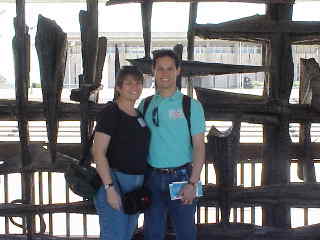 The tour of the Knesset was somewhat shortened, or at least seemed
that way, because parliament wasn't in session (it was on a campaign
break in preparation for the elections May 18). But it was a good tour
nonetheless.
The tour of the Knesset was somewhat shortened, or at least seemed
that way, because parliament wasn't in session (it was on a campaign
break in preparation for the elections May 18). But it was a good tour
nonetheless.
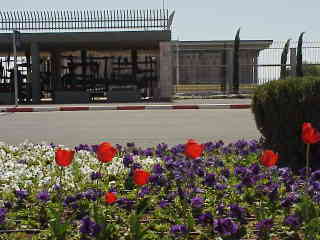
The main thing I didn't like about the tour was cameras weren't allowed; it was a great building, but the security was extreme (especially in comparison to the Supreme Court, about which more below).
We had to show our passports, wear nametags, and leave our cameras at
the gatehouse. But we did learn how our names are spelled in Hebrew, as
they were printed on our nametags. Not the best of trade-offs, but oh well.
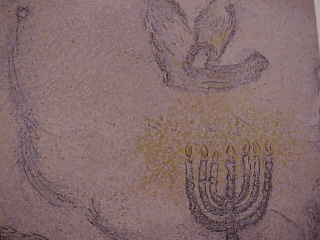 The highlight, for Adam at least, was the Chagall stateroom,
which is a large hall used for special occasions. In it were three
Chagall tapestries and a large wall mosaic, as well as twelve mosaics
on the floor representing the twelve tribes of Israel. A portion of
the wall mosaic is shown at right, and portions of two of the
tapestries are shown below.
The highlight, for Adam at least, was the Chagall stateroom,
which is a large hall used for special occasions. In it were three
Chagall tapestries and a large wall mosaic, as well as twelve mosaics
on the floor representing the twelve tribes of Israel. A portion of
the wall mosaic is shown at right, and portions of two of the
tapestries are shown below.
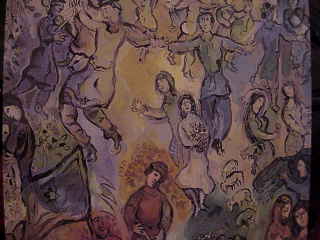
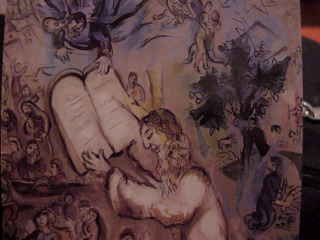
Some people wrote to us later that they really liked the pictures of
the tapestries and mosaics included above, yet no one seemed to notice
that I had pictures of them despite saying only a few paragraphs earlier
that cameras weren't allowed inside the tour. How did we get pictures,
an observant reader might notice? Well, later that day, in the Israel Museum
gift shop, I saw postcards with pictures of the tapestries and mosaics,
and yet another nice feature of the Mavica is that it takes excellent
close-up photos. So, I placed the postcards on the bed when I got
back to Akiva's, held the camera steady, and presto! You too were
able to see what the mosaics looked like! Moreover, if you hadn't
read this page, you wouldn't have known the trick, because I didn't
clue people in earlier on the original page. Aren't you lucky?
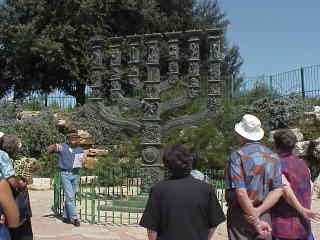 Anyway, after the Knesset tour, we walked through an international garden to
the Supreme Court. The huge menorah shown is directly across from the
Knesset, and in it are sculpted several biblical scenes, but you
probably can't tell that from the photo.
Anyway, after the Knesset tour, we walked through an international garden to
the Supreme Court. The huge menorah shown is directly across from the
Knesset, and in it are sculpted several biblical scenes, but you
probably can't tell that from the photo.
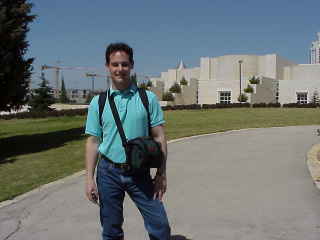 The photo to the left is of Adam with the (relatively) new Supreme
Court building behind him. It was opened in 1992, which means it
wasn't listed in any of the guidebooks we had (for some reason, the
Fodor's we have is from 1993, yet it was the latest printing!).
Luckily, Akiva recommended that we go there, and he found out that it
has English-language tours on Thursdays at noon (the Knesset's
English-language tours are Thursdays and Sundays at 10 a.m.).
The photo to the left is of Adam with the (relatively) new Supreme
Court building behind him. It was opened in 1992, which means it
wasn't listed in any of the guidebooks we had (for some reason, the
Fodor's we have is from 1993, yet it was the latest printing!).
Luckily, Akiva recommended that we go there, and he found out that it
has English-language tours on Thursdays at noon (the Knesset's
English-language tours are Thursdays and Sundays at 10 a.m.).
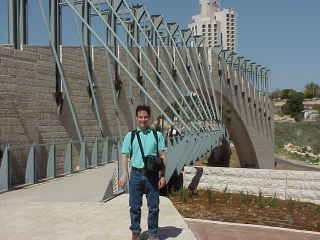
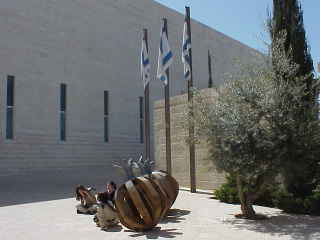
The Supreme Court is a beautiful building, designed by Tel Aviv-based
architects and funded by the Rothschild family. The bridge behind Adam
in the photo to the left above, and the sculpted pomegranates in the
photo on the right, weren't specifically described, but the tour was
quite informative, explaining the design concepts and goals, about which
more below.
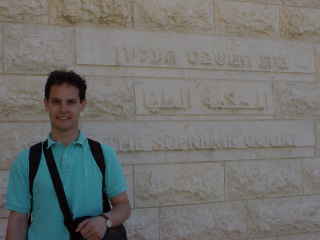 Hello, folks, it's Adam the "architecture expert" (having taken one
college class in the architecture of Frank Lloyd Wright) here to tell
you about the quite fascinating architecture of the Israeli Supreme
Court. As it says in the photo to the right. Not that anyone can read it
since the contrast wasn't high enough. Well, you can't ask for everything
from a digital camera. The court wreaked havoc with our camera because
it is filled with natural light, and the play of light and dark was too
much for Sony to handle.
Hello, folks, it's Adam the "architecture expert" (having taken one
college class in the architecture of Frank Lloyd Wright) here to tell
you about the quite fascinating architecture of the Israeli Supreme
Court. As it says in the photo to the right. Not that anyone can read it
since the contrast wasn't high enough. Well, you can't ask for everything
from a digital camera. The court wreaked havoc with our camera because
it is filled with natural light, and the play of light and dark was too
much for Sony to handle.
 One enters the building through a low portal, a kind of ceremonial
entrance (used in many Frank Lloyd Wright buildings, by the way) into
a passageway with stairs that narrow towards the top. These stairs are
supposed to represent a side street in Jerusalem; to their right is
a huge wall of Jerusalem stone looking very much like the Western Wall.
At the top of the stairs is a panoramic view of Jerusalem in three-story
windows.
One enters the building through a low portal, a kind of ceremonial
entrance (used in many Frank Lloyd Wright buildings, by the way) into
a passageway with stairs that narrow towards the top. These stairs are
supposed to represent a side street in Jerusalem; to their right is
a huge wall of Jerusalem stone looking very much like the Western Wall.
At the top of the stairs is a panoramic view of Jerusalem in three-story
windows.
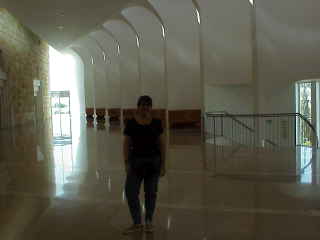 Pass under another portal and one enters the anteroom outside the library.
Pass under another portal and one enters the anteroom outside the library.
Unlike many courts in which the libraries are closed and cloistered, the library in the Supreme Court building is open to public view through glass walls.
In case you're confused, the library is the image above to the left.
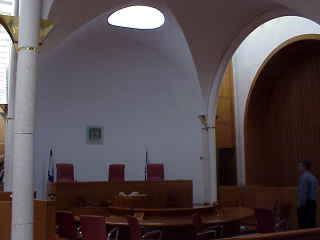 After the library, a visitor enters the main room, with huge
circular inlets rising out of niches at the base, which also provide
seating for the public and jurists. (The picture above is of Monica in this
hallway, though she is backlit and it's kind of difficult to see her.)
The right-hand side with the niches
symbolizes new Jerusalem with its modern lines while the left hand side,
containing Old City-like gates, symbolizes old Jerusalem and its laws and
traditions. By the way, the old part faces towards the Old City and the
new part faces towards Tel Aviv. Neat, no?
After the library, a visitor enters the main room, with huge
circular inlets rising out of niches at the base, which also provide
seating for the public and jurists. (The picture above is of Monica in this
hallway, though she is backlit and it's kind of difficult to see her.)
The right-hand side with the niches
symbolizes new Jerusalem with its modern lines while the left hand side,
containing Old City-like gates, symbolizes old Jerusalem and its laws and
traditions. By the way, the old part faces towards the Old City and the
new part faces towards Tel Aviv. Neat, no?
 Each courtroom is modeled after a particular synagogue (we saw only
this one courtroom). The judges enter from behind the far wall,
and the accused (when there are any) enter from behind a side wall.
The public galleries are very open and make an attempt to merge the
modern with the traditional (representing ancient legal judgment).
Note the circular skylight in the ceiling of the courtroom. This circle
is part of a greater theme in the building of circles and lines.
Each courtroom is modeled after a particular synagogue (we saw only
this one courtroom). The judges enter from behind the far wall,
and the accused (when there are any) enter from behind a side wall.
The public galleries are very open and make an attempt to merge the
modern with the traditional (representing ancient legal judgment).
Note the circular skylight in the ceiling of the courtroom. This circle
is part of a greater theme in the building of circles and lines.
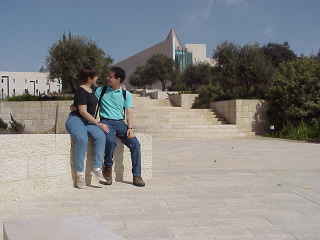 The
circle represents judgment and the law, which involves discussion and
which can change, and the line represents truth, which is straight
and unerring. The courtyard pictured above brings these two elements
together in the center of the building in a little fountain. The origin
of the fountain bubbles and splashes, showing the dynamism of the idea of
justice, and the water subsequently flows down the straight path of the law.
The
circle represents judgment and the law, which involves discussion and
which can change, and the line represents truth, which is straight
and unerring. The courtyard pictured above brings these two elements
together in the center of the building in a little fountain. The origin
of the fountain bubbles and splashes, showing the dynamism of the idea of
justice, and the water subsequently flows down the straight path of the law.
Okay, the image to the left is just a cute moment with no particular architectural significance.
(We took it with the timed feature on the camera, as there was no one around to get a
picture of both of us together.)
If anything, the one interesting note here is the pyramidal structure on the right side
of the picture. Pyramids are also a theme in the Supreme Court building; the main entrance
area next to the library has a huge pyramid over head with circular
skylights (it's pretty cool). What you are seeing is not that pyramid, but
you get the general idea. Also, the garden to the right connects to the
Knesset, and one particular view down a courtyard allows the viewer to
glimpse the Knesset in the distance.
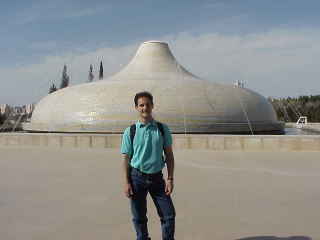 After the Supreme Court, we walked down the hill (thankfully, after
all that uphill) to the Israel Museum and the Dead Sea Scrolls, and
took lots of lovely pictures of the building housing the scrolls.
After the Supreme Court, we walked down the hill (thankfully, after
all that uphill) to the Israel Museum and the Dead Sea Scrolls, and
took lots of lovely pictures of the building housing the scrolls.
The picture to the right is of Adam, taken before we went in.
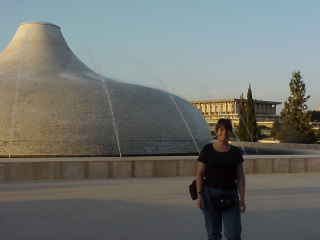 After touring the museum, Monica had this photo taken, with the Knesset in the background.
After touring the museum, Monica had this photo taken, with the Knesset in the background.
The Hershey-kiss-shaped building, called the Shrine of the Book, is in the shape of the top of one of the clay vessels in which the scrolls were found. We saw the actual vessels downstairs.
We were impressed with the condition of the scrolls and the detail on the hand-inscribed micrography on some of the surviving tefillin scrolls.
From the exhibit, it sounds
like the Sectarians didn't have much fun out in the desert, but they sure
left us a treasure.
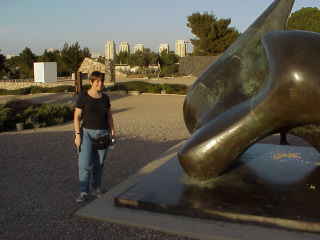
Up the hill a bit we visited the Billy Rose Sculpture Garden briefly and then the Israel Museum's modern art collection.
These two pictures below were taken in the sculpture garden. As the
Beatles say, "All you need is love..." (Ahava is Hebrew for Love, for those who didn't know.)
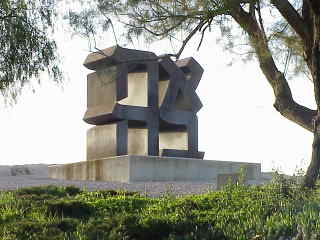
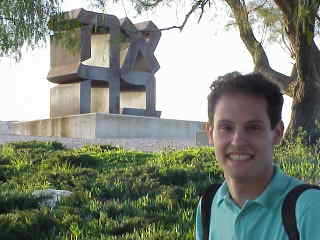
Inside the museum, where we could not take pictures, we found a very funny modern art piece called "Mother." It was a metal cabinet with a large stuffed-animal elephant on the top. Every few seconds there was a great whirring sound like a vaccuum cleaner, and the elephant's stomach filled with air, the trunk raised a bit, and the top front and back legs flopped. Then the noise wound down and the elephant "breathed out." It sounded distinctly like snoring. We were in stitches. (Monica here: I can only imagine what the artist must have thought of his mom, to "name" this work "after her.")
After a brief look at the archaeology section of the museum (it was closing,
so they shooed us out), we headed back to join Akiva Ilan (our host, for
those of you who are just tuning in) for dinner.
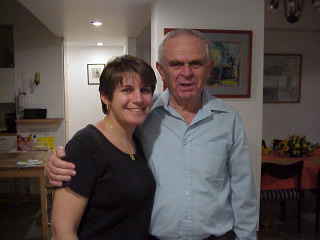 We went to a place Akiva
originally described as "Argentinian" but that turned out to be a kind
of Mexican chicken restaurant. The food was fair, but the company was great.
We went to a place Akiva
originally described as "Argentinian" but that turned out to be a kind
of Mexican chicken restaurant. The food was fair, but the company was great.
The three of us spoke mostly about Israel, Monica's and my jobs, and Akiva's
kids. Apparently, Israel is in a significant to severe recession, with
unemployment around 10 percent. Akiva's kids, on the other hand,
are thriving (two are in the States,
and the third works in high technology here in Israel).
Akiva mentioned that he could hardly wait to see his granddaughter
Kalia again and to see his son Oded's new baby. He's quite the
proud grandpa, of course.
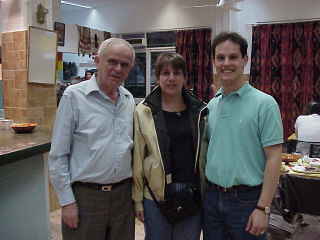 The picture to the left was taken in the "Argentinian" restaurant--"Poyo Loko" was the
English translation, though we think they meant Pollo Loco. Monica was
particularly amused by the restaurant, as it reminded her of home (except they
served the chicken with large, fresh-made pita bread rather than with tortillas).
The picture to the left was taken in the "Argentinian" restaurant--"Poyo Loko" was the
English translation, though we think they meant Pollo Loco. Monica was
particularly amused by the restaurant, as it reminded her of home (except they
served the chicken with large, fresh-made pita bread rather than with tortillas).
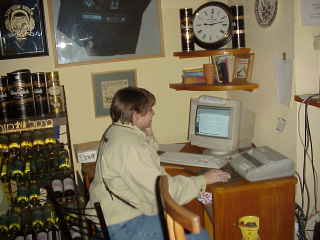 (Monica again.)
(Monica again.)
After dinner, Adam and I headed to NetCafe, but it
was quite busy (it was Thursday night--the equivalent of Friday night
in the States--beginning of the weekend. So we thought,
in the interests of journalism, that we would try Strudel,
the cybercafe we had originally intended to visit when we
happened upon NetCafe instead. But, as we had heard, Strudel
is more of a "NetBar," with smoking allowed and the emphasis being much
more on the bar than on the 'net, it seemed.
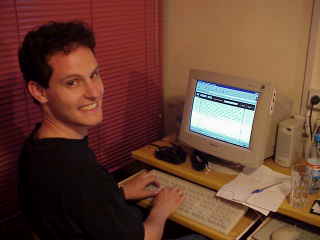 At NetCafe, pictured to the left, with Adam at the PC, the emphasis
seems to be much more on the 'net and on the cafe (the downstairs has
an espresso machine and, as we mentioned before, serves kosher-dairy food and snacks;
it does serve bottled beer, but being a "bar" doesn't seem to be its main focus.
At NetCafe, pictured to the left, with Adam at the PC, the emphasis
seems to be much more on the 'net and on the cafe (the downstairs has
an espresso machine and, as we mentioned before, serves kosher-dairy food and snacks;
it does serve bottled beer, but being a "bar" doesn't seem to be its main focus.
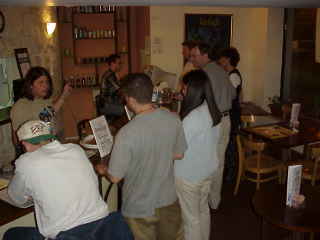 Anyway, we returned to NetCafe after checking out our HotMail messages at Strudel,
and we waited a bit until a computer was available. Then I started this
page, and Adam (being the wonderful husband that he is) ran back to
Akiva's to pick up the two disks that I forgot to bring with me (oops!). Upon
his return, he proceeded to add his impressions to the page (see above),
and the image above is of him doing so.
Anyway, we returned to NetCafe after checking out our HotMail messages at Strudel,
and we waited a bit until a computer was available. Then I started this
page, and Adam (being the wonderful husband that he is) ran back to
Akiva's to pick up the two disks that I forgot to bring with me (oops!). Upon
his return, he proceeded to add his impressions to the page (see above),
and the image above is of him doing so.
And so ended Day 5 (March 18).
To continue your cybertour, click here.
To go back to the previous page, click here.
To go to the original main page, click here.
Or to go to the edited homepage, click here.
And, of course, feel free to write to us.
Last updated on July 10, 1999.